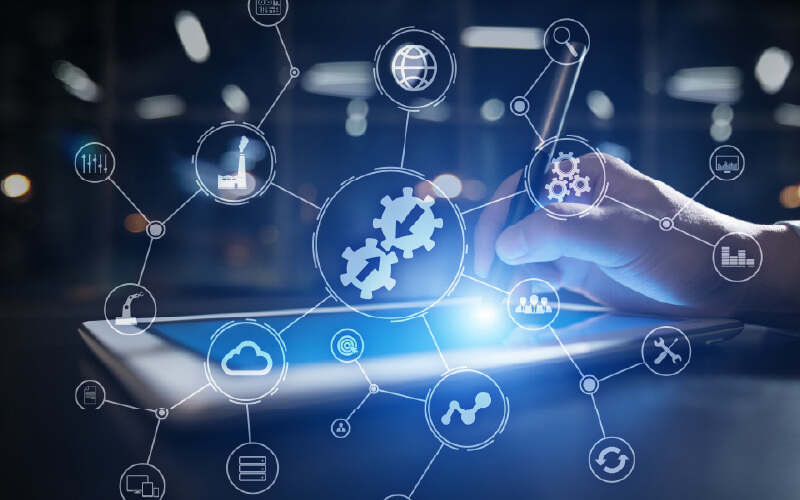This website uses cookies. By continuing to browse the site, you are agreeing to our use of cookies
Mainframe Modernization – Unlock 360° value on Cloud
Digital Core Transformation
September 30, 2022
Mainframe systems have been a foundation for business applications for several decades. However, running these decades-old legacy systems is not sustainable and cost-effective and poses challenges such as inefficiency, uncertainties, and security risks. Moreover, working on these systems requires skilled programmers having expertise in mainframe programming as well as good knowledge of the business domain. With time, applications incrementally get burdened with new loads and data, impacting their performance. Also, making changes or troubleshooting old code poses a massive challenge for organizations. Organizations are looking to make these applications efficient and proficient to keep pace with the new technology and stay competitive.
Mainframe modernization replaces old and outdated mainframe applications and systems used in an organization with new and enhanced applications. In several organizations, the infrastructure used for the legacy mainframe technology is decades old and outdated, but organizations still rely upon them for their operations. These legacy Mainframe systems run foundational business applications and are often obtained against a heavy upfront cost (capital expenditure). Moreover, they are often accompanied by various supporting applications and massive amounts of data, all running together to support the foundational business processes. Therefore, organizations find it challenging to replace them and continue using them until they break down.
Why should you modernize and move your mainframe applications to the cloud?
As any business grows, mainframe applications running for an extended period tend to get overburdened with additional loads. Therefore, timely upkeep and fine-tuning of these applications remain essential to ensure these systems’ long-lasting performance and efficiency.
Application cloud migration and modernization with a well-planned strategy would ensure that the targeted goals are aligned with the business objectives, thus enabling a faster time to market in the most economical ways. A modern mainframe infrastructure would ensure that the underlying infrastructure is optimally used without overburning the resources or leaving them underutilized.
For any organization, the right migration strategy would include selecting the appropriate cloud migration approach, such as rewriting, rehosting, refactoring, or re-platforming. It also includes setting up the budget, timeframe, and allocation of other appropriate resources required for the migration process. Moreover, selecting the right architecture also plays a significant role in the success of migration efforts. An optimized application architecture, fine-tuned to the specific business requirements, can help reduce operational costs and boost the overall system’s efficiency and performance.
Thus, investment in mainframe application migration and modernization on the cloud can help set up the right environment for running current workloads and planning for future requirements while reducing the Total Cost of Ownership (TCO).
Risks involved in mainframe modernization
Mainframe modernization includes a thorough inspection and analysis of the existing infrastructure and identification of the modules suitable for modernization. Modernization can include multiple solutions in several possible combinations, like migration, rehosting, or rewriting of the mainframe applications entirely into a new mainframe environment. Depending upon requirements, it often includes migration to a multi-cloud system or hybrid environment.
While implementing these scenarios, some risks may be involved, which, if not tackled properly, may create havoc. For example, while migrating the application, there are chances of loss of some data or functionality. Rewriting specific applications may result in some unexpected performance issues while interacting with other legacy applications or programming languages. Therefore, it is essential to find a modernization solution that can be upgraded or tweaked over a later period while continuing to remain connected with other legacy applications running across the infrastructure.
Mainframe application modernization – Strategies and techniques
Modernization of legacy Mainframe applications is often way more than just updating the system. There are several ways in which any legacy system can be modernized, such as rehosting the applications to a new platform or rewriting the entire code for the new environment. Moreover, depending upon the existing state of applications and business goals, organizations may choose to deploy multiple approaches or services to achieve the desired state of business agility.
Mainframe application modernization approaches can be broadly categorized as follows:
1. Rewriting
Legacy applications may be written in some monolithic code, and writing new code or adding new features could be difficult. Finding suitably skilled resources that could understand the existing code and perform enhancements using the same old programming language could be difficult. Therefore, organizations may rewrite the entire code manually or via automated tools.
2. Rehost or Re-platform
Rehosting the existing application to a new platform allows you to operate them in the cloud without making significant changes. Some parts of the code may be modified to ensure proper interactions with external entities, such as databases.
3. Replace
A straightforward approach is to discard the legacy application and start using any commercially available ‘off-the-shelf’ package or some ready-to-use Software-as-a-Service (SaaS) offering, such as Salesforce or Policy Administration System (PAS). These packages have various functionalities and capabilities for users to choose from. While opting for this, users need to ensure that it can integrate with other applications running in the environment and has the desired capabilities like user interfaces and analytical reports they might need to keep an eye on the system’s status. This approach is very fast to implement, and it is easy to validate if the provider offers any assurance about security and compliance requirements.
4. Retain
There are often situations where organizations may want to retain their legacy system at any cost. This may be due to the lack of any other system that could provide the exact functionality to meet all the requirements or to avoid any possible breakdown of any complex integration involving multiple applications. There are chances that the organization is using the legacy system only to produce data that is required occasionally, such as for audits or compliance. Organizations can retain the applications in such scenarios by archiving them to low-cost storage and using them only when needed.
5. Unified DevOps
Adopting DevOps for Legacy could be considered a dynamic step towards modernization. Establishing centralized code repositories, unified Integrated Development Environments (IDE), and working with automated testing provides a unified approach toward modernization. This enables updated code to be integrated with the central code repository, preventing faster turn-around and error-free build releases. Organizations can implement the changes in small sprints, thus minimizing any risks of failure.
6. Data Modernization
Several organizations that deal with data-heavy workloads, such as banks and financial organizations, are facing incremental costs for managing the legacy datasets like VSAM, ISAM, IDMS, IMS, etc. They can migrate their data to modern databases to enjoy the benefits such as business agility and scalability. Migration to robust database systems such as NoSQL or cloud-based databases enables advanced scenarios with support for mobility, cloud computing, social media, and big data.
7. Optimize the Legacy systems
Optimizing the usage of existing resources can help increase the overall efficiency of the legacy mainframe systems. Monitoring and controlling the mainframe MIPS usage could help optimize and control its use, thus saving costs. By monitoring the systems, workloads, databases, and code for the mainframe applications, it is possible to achieve a 12-35% reduction in MIPS utilization within six months.
8. API-enabled access
Writing APIs for integration between various systems provides an easy way to perform multiple tasks or share information. To take advantage of this, legacy monolith applications can be customized and exposed via APIs. For this, applications need to be decoupled into independent functions and rewritten as microservices, which can be accessed via API calls. This enables easy integration of mainframe systems with other platforms and applications, thus widening the scope of their operations.
Benefits of Mainframe Modernization
The key benefits of Mainframe modernization to the cloud are as follows:
Operational efficiency
Housing the entire infrastructure required to run mainframe systems demands a considerable budget. Monitoring and securing the infrastructure adds to the systems’ operational costs. Migration to a modern cloud-based model can help reduce operational expenditure and save efforts spent on management and maintenance tasks (like patching and updates) of infrastructure used to host the mainframe applications.
More Automation
Besides automation in maintenance, updating the technology opens the doors for automation possibilities for various other tasks like routine audits, health checks, etc. Moreover, ML and AI-based automation further enable the handling of any errors or anomalies in the inputs, ensuring better business continuity.
Improve Productivity
Migrating the legacy systems to a more automated setup frees up the IT resources from making efforts to move the old elephant. They need not invest time in fixing the problems within the code and can focus on other higher-level issues.
Skill Shift
Organizations must not depend on the mainframe software’s aging code writers by migrating to modern platforms. They benefit from the wide availability of skillset among the young code-writers and engineers. Moreover, by tapping into the fresh engineering talent, they can avoid vendor lock-ins by opting to modernize with open-source software.
Competitive advantage
By adopting new technology, systems become more adaptable to new trends and innovation, thus bringing in competitive advantage. The modern platform allows organizations to be ready to adapt to any new scenario, like new marketing events or product launches, providing a competitive edge over other players in the market.
Rapid Mainframe Application Migration and Modernization with Amaze® for Legacy
Hexaware’s Amaze® for Legacy is an automation-driven framework that helps transform your applications to run efficiently on cloud.
The platform combines proprietary accelerators and partner tools to perform automated discovery, functional domain decoupling, and accelerated migration. The accent on automation ensures that their mainframe modernization and migration to cloud journey is seamless with no disruption to business and accelerates the path to holistic digital transformation.
To know more on Amaze® for Legacy, check out the flyer here.
Know how 33% faster rewriting helped a global investment management firm reduce costs on their mainframe modernization journey.
Hexaware’s Digital Core Transformation (DCT) offerings are focused on enabling the Enterprise’s Core IT to be ready to drive the hypervelocity needed by businesses in their digital transformation journey. Explore our services spectrum here.
About the Author

Rajeshkannan M
Read more
Related Blogs

Prompt Engineering: From Art to Science – III
- Digital Core Transformation

Prompt Engineering: From Art to Science – II
- Digital Core Transformation

Prompt Engineering: From Art to Science
- Digital Core Transformation
- Generative AI

Generative AI for Coding: Taming the Holy Beast!
- Digital Core Transformation
- Generative AI

Maximize the value of Transformation with an Enhanced Governance Capability
- Digital Core Transformation

Simplifying Hybrid Integration: Its importance in the digital era
- Digital Core Transformation

Top 8 Legacy Modernization Approaches
- Digital Core Transformation

Cloud Security vs On-premises Security: What’s the Difference?
- Digital Core Transformation

Data Fabric: An established imperative for the digital era
- Digital Core Transformation

The Benefits of Enterprise Performance Management (EPM) System
- Digital Core Transformation

Ready to Pursue Opportunity?
Every outcome starts with a conversation







